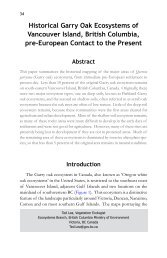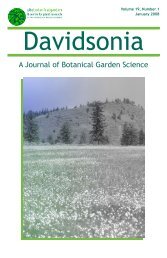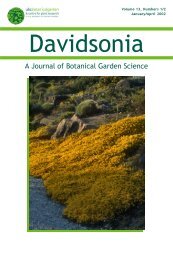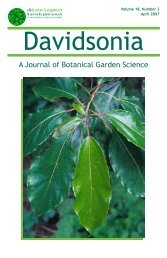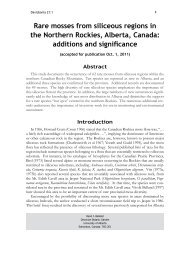pdf wkg Dav.14-14 - Davidsonia
pdf wkg Dav.14-14 - Davidsonia
pdf wkg Dav.14-14 - Davidsonia
Create successful ePaper yourself
Turn your PDF publications into a flip-book with our unique Google optimized e-Paper software.
<strong>Davidsonia</strong> <strong>14</strong>:4<br />
113<br />
Although ideally suited to their primary role, chlorophyll molecules easily<br />
break down due to their inherent instability, especially under the high-intensity<br />
photon bombardment of sunlight. The photons stimulate chlorophyll<br />
molecules to release excited electrons, disrupting the molecular bonds which<br />
hold the component atoms together. This is an exothermic reaction, after<br />
which the molecules achieve a more stable state in another form. This<br />
photooxidation of chlorophyll takes place throughout the leaf ’s green life.<br />
Normally, the chlorophyll thus destroyed is replaced by newly synthesized<br />
chlorophyll. In autumn, however, the synthesis of replacement chlorophyll<br />
stops.<br />
Environmental triggers contribute to autumn colour change<br />
In addition to providing the driving energy for photosynthesis, light influences<br />
the timing, magnitude and degree of leaf colour change and not only<br />
by destroying chlorophyll. Brighter sunlight tends to produce the most vivid<br />
colours, primarily when temperatures are low. Leaf age is also a factor,<br />
since the physiology and functions inherent in younger leaves differ from<br />
older leaves and they are less apt (or “competent”) in responding to the<br />
longer nights and lower temperatures of autumn. Younger leaves, therefore,<br />
turn colour after mature leaves on the same tree (Figure 2). The foliage of<br />
Larix lyallii (sub-alpine larch) turns colour later into the autumn in years<br />
where leaf emergence has been delayed by cold spring weather (Worrall, 1993).<br />
On the other hand, drought and nutrient stress (Schaberg et al., 2003)<br />
contribute to earlier fading of green and the appearance of other colours.<br />
Often it is the tissues immediately adjacent to the veins that are the last to<br />
turn colour (Figure 3).<br />
A reddening of foliage and other green tissues is not restricted to the<br />
autumn or to deciduous trees (Steyn et al., 2002). Even Pinus banksiana (jack<br />
pine) seedlings become stained with purple in the autumn (Nozzolillo et al.,<br />
2002). Other examples include the frequent bright reddish or purple tinge<br />
in many high-elevation plant species emerging through brilliant white snow,<br />
the red “snow algae” in montane and alpine sites, and the reddish cast in the<br />
winter foliage of several conifers (especially the Taxaceae, including the yews<br />
and redwoods, and Cupressaceae, including the cypresses) (Weger et al., 1993;<br />
Han et al., 2003). Many sun-exposed plants will also redden in summer in<br />
response to drought, nutrient or salt stress (Figure 4).



